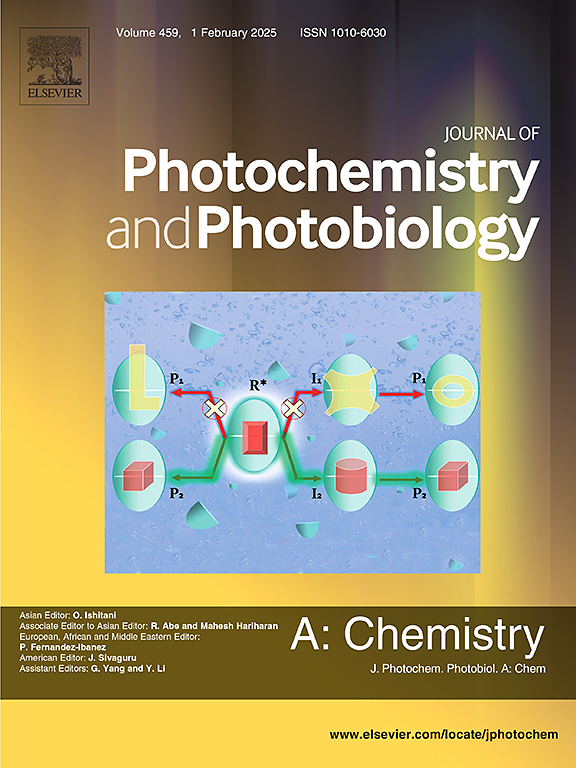Engineering a pH-responsive fluorometric system: Dual-emission carbon dots and BTB for selective urea sensing
IF 4.1
3区 化学
Q2 CHEMISTRY, PHYSICAL
Journal of Photochemistry and Photobiology A-chemistry
Pub Date : 2025-03-29
DOI:10.1016/j.jphotochem.2025.116416
引用次数: 0
Abstract
Reliable detection of urea levels is critical for tracking kidney health, identifying diseases, and studying essential physiological functions. Here, we present a novel, straightforward, and selective fluorometric method for urea detection based on a dual-emission carbon dots system coupled with bromothymol blue (BTB) as a pH-sensitive indicator. The sensing platform consists of uniquely engineered carbon dots exhibiting dual emission peaks at 442 nm and 612 nm, working in conjunction with BTB in the presence of urease. The detection mechanism relies on urease-catalyzed hydrolysis of urea, which generates ammonia and subsequently increases the local pH. This pH elevation triggers a distinct color transformation of BTB from yellow (430 nm) to blue (615 nm), simultaneously causing a drop in fluorescence intensity at 612 nm and a rise at 442 nm, enabling ratiometric detection of urea. The developed method demonstrates excellent analytical performance with good linearity (R2 = 0.9937) across a concentration range of 10.0–100.0 μM and achieves a detection limit of 2.86 μM. Notably, the method exhibits remarkable selectivity in complex biological matrices, successfully quantifying urea in human serum samples with high recovery values despite the presence of potential interferents. Furthermore, we extended the application of this sensing system to develop a smartphone-based colorimetric detection platform, enhancing its accessibility for point-of-care diagnostics. This dual-mode detection method provides a fast and dependable tool for urea monitoring in clinical and biological applications.

设计一个ph响应荧光测量系统:双发射碳点和BTB用于选择性尿素传感
尿素水平的可靠检测对于跟踪肾脏健康、识别疾病和研究基本生理功能至关重要。在这里,我们提出了一种新的、直接的、选择性的尿素荧光检测方法,该方法基于双发射碳点系统耦合溴百里酚蓝(BTB)作为ph敏感指示剂。该传感平台由独特设计的碳点组成,具有442 nm和612 nm的双发射峰,在脲酶存在下与BTB协同工作。检测机制依赖于脲酶催化的尿素水解,产生氨,随后增加局部pH值。pH值的升高触发BTB从黄色(430 nm)到蓝色(615 nm)的明显颜色转变,同时导致612 nm处荧光强度下降,442 nm处荧光强度上升,从而实现尿素的比例检测。该方法在10.0 ~ 100.0 μM的浓度范围内具有良好的线性关系(R2 = 0.9937),检测限为2.86 μM。值得注意的是,该方法在复杂的生物基质中表现出显著的选择性,尽管存在潜在的干扰,但仍能成功定量人血清样品中的尿素,回收率高。此外,我们扩展了该传感系统的应用,以开发基于智能手机的比色检测平台,提高了其对即时诊断的可及性。这种双模检测方法为临床和生物学应用提供了一种快速可靠的尿素监测工具。
本文章由计算机程序翻译,如有差异,请以英文原文为准。
求助全文
约1分钟内获得全文
求助全文
来源期刊
CiteScore
7.90
自引率
7.00%
发文量
580
审稿时长
48 days
期刊介绍:
JPPA publishes the results of fundamental studies on all aspects of chemical phenomena induced by interactions between light and molecules/matter of all kinds.
All systems capable of being described at the molecular or integrated multimolecular level are appropriate for the journal. This includes all molecular chemical species as well as biomolecular, supramolecular, polymer and other macromolecular systems, as well as solid state photochemistry. In addition, the journal publishes studies of semiconductor and other photoactive organic and inorganic materials, photocatalysis (organic, inorganic, supramolecular and superconductor).
The scope includes condensed and gas phase photochemistry, as well as synchrotron radiation chemistry. A broad range of processes and techniques in photochemistry are covered such as light induced energy, electron and proton transfer; nonlinear photochemical behavior; mechanistic investigation of photochemical reactions and identification of the products of photochemical reactions; quantum yield determinations and measurements of rate constants for primary and secondary photochemical processes; steady-state and time-resolved emission, ultrafast spectroscopic methods, single molecule spectroscopy, time resolved X-ray diffraction, luminescence microscopy, and scattering spectroscopy applied to photochemistry. Papers in emerging and applied areas such as luminescent sensors, electroluminescence, solar energy conversion, atmospheric photochemistry, environmental remediation, and related photocatalytic chemistry are also welcome.

 求助内容:
求助内容: 应助结果提醒方式:
应助结果提醒方式:


